| dc.contributor.author | Gonzalez-Longatt, Francisco | |
| dc.contributor.author | Montalvo, Martha Nohemi | |
| dc.contributor.author | Andrade, Manuel A. | |
| dc.contributor.author | Vazquez, Ernesto | |
| dc.contributor.author | Chamorro, Harold R. | |
| dc.contributor.author | Sood, Vijay K. | |
| dc.date.accessioned | 2021-08-05T10:09:51Z | |
| dc.date.available | 2021-08-05T10:09:51Z | |
| dc.date.created | 2021-01-27T21:31:28Z | |
| dc.date.issued | 2020 | |
| dc.identifier.citation | Gonzalez-Longatt, F., Acosta, M. N., Andrade, M., Vazquez, E., Chamorro, H. R., & Sood, V. K. (2020). Multi-Core Platform of Admittance Matrix Formation of Power Systems: Computational Time Assessment. In 2020 IEEE Electric Power and Energy Conference (EPEC) | en_US |
| dc.identifier.isbn | 978-1-7281-6489-2 | |
| dc.identifier.uri | https://hdl.handle.net/11250/2766445 | |
| dc.description.abstract | This paper presents a comparison of computational time required to build the admittance matrix of five test systems (ranging from 200 to 70,000 nodes) considering two formation approaches: element-by-element and matrix approach. The algorithms have been implemented in MATLAB ™ and tested in four multi-core platforms. Implementations include sparse and dense matrix representation and parallel/non-parallel computing. Results show the matrix approach considering sparse representation and parallel computing is the best approach in computing time. | en_US |
| dc.language.iso | eng | en_US |
| dc.relation.ispartof | Proceedings of the Electric Power and Energy Conference (EPEC), 2020 IEEE | |
| dc.title | Multi-Core Platform of Admittance Matrix Formation of Power Systems: Computational Time Assessment | en_US |
| dc.type | Chapter | en_US |
| dc.description.version | acceptedVersion | en_US |
| dc.rights.holder | © 2020 IEEE. | en_US |
| dc.source.journal | 2020 IEEE Electric Power and Energy Conference (EPEC) | en_US |
| dc.identifier.doi | https://doi.org/10.1109/EPEC48502.2020.9320060 | |
| dc.identifier.cristin | 1880776 | |
| cristin.ispublished | true | |
| cristin.fulltext | original | |
| cristin.qualitycode | 1 | |
